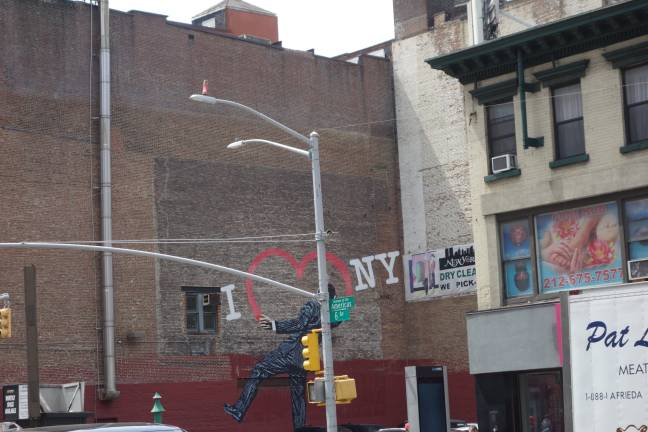religious power lines

New York is a city rife with unparalleled opportunities of discovery. There are the mysterious entities that baffle the average tourist but that can be explained by a seasoned New Yorker, such as that frenetic fifteen-digit digital display (yes, it’s a clock) at Union Square, and the absolutely logical-once-it’s-explained-to-you layout of the street grid, its address, flow of traffic and numbering. But there is one thing that I noticed upon first moving here that was never elucidated until recently. It was my dad, in fact, who called me one random Saturday morning, asking if I had ever seen “those transparent wires that span between lampposts or power lines” high above the streets. I responded that of course, I definitely had seen them, right here in Chelsea, but no, I had no idea. Because while I had wondered before what they were, I actually forgot about my curiosity at some point. I recall once having been told that they were some sort of grounding wire for power lines, or a deterrent for pigeons or some such, and left it at that. My dad (as he so often does), had the real explanation.
An eruv is an adaptation that some of more stringent Jewish communities, especially Orthodox ones, construct to enable a prohibited activity to be performed on Shabbat, Judaism’s holy day of rest. These are created from durable nylon lines, called mechitzas, which are basically expanded property boundaries, allowing Orthodox Jews to perform some limited tasks that are otherwise prohibited on the Sabbath, such a lifting a child, pushing a stroller or even carrying a book or pencil. Without them, functioning in modern society would be virtually impossible. These adaptive constructs expand what is considered the private domain to a larger scale, which provide followers more lenient behavioral allowances and a greater area of real estate in which to exist, albeit in a somewhat controversial fashion.
You can find a map of the eruv on eruv.nyc. The first eruv was constructed in New York City in 1905, and now encompasses the whole of Manhattan all the way up to 145th Street. That said, a network of lines still criss-cross Avenue of the Americas, although exactly to what end I couldn’t determine. But according to eruv.nyc, these lines are redundant, and needn’t even be there, a verdict confirmed by Rabbi Adam Mintz, a Modern Orthodox rabbi who is also a professor at City College. Mintz qualified that his is not a Halachic opinion, based on Jewish religious law, further illustrating a hierarchy of adherence and interpretation of Jewish regulations.
An Official “Eruv Checker”I followed the line that runs above Sixth avenue from West 8th Street as it crosses from street lamp to traffic signal, all the way up to 25th Street, its transparency making it sometimes difficult to perceive until a glint of sunlight reflects off of it. All of a sudden, however, the line disappeared, and I was quite shocked to see the broken filament dangling from above. It’s something I never would have even noticed had I not been researching the phenomenon, but it is fate that the lines would inevitably break at some point. I reported the incident to the contact listed on eruv.nyc, but this was apparently unnecessary. According to Mintz, there is an official “eruv checker” who on every Thursday morning at the jarring hour of four a.m., circumnavigates the entire eruv network to make sure it is all intact in anticipation of the Sabbath. Any repairs are made that afternoon, like clockwork, and he revisits each site at which a repair is made to confirm the integrity of the eruv. Mintz even recounted a story that this legendary man’s daughter was wed on a Wednesday evening one year, but sure enough, on Thursday at 4 a.m. he was on the job, ensuring that all the lines were intact.
As is most everything these days, the eruv are quite controversial, but less among non-Jews, most of whom aren’t even aware of the practice. The divide emerges more vigorously between the communities who practice varying degrees of stringency in regards to adherence of Halacha as they interpret it. That eruv translates to “loophole” basically makes the controversy self-explanatory. Some find it an ingenious resolution to facilitate adherence to Orthodox law in modern day society, where others consider it cheating. On this, the jury is still out, and may always be. It’s not a black-and-white issue, and much like all tenets of religion one must decide for one’s self what level of devotion makes the most sense personally. But adhering to a scientific mindset myself, finding out the meaning behind the strings was fascinating from a historical perspective.
If you have never noticed an eruv line in your neighborhood, perhaps it is just a matter of time. Mintz hypothesizes that the eruv will “persist and expand” to accommodate Orthodox laws in modern society. Which, ostensibly, could go one of two ways: creating an even greater amount of real estate in which to perpetuate a more segregated existence, or a relaxing of the rigorous restrictions of the religion, something that might facilitate cohabitation with the rest of society. No one ever said religion was without controversy.